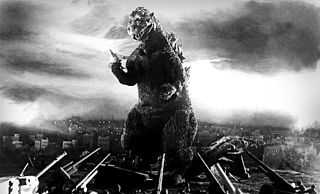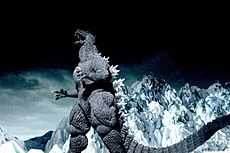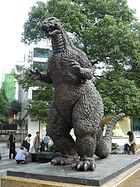Godzilla
| Godzilla | |
|---|---|
 Godzilla portrayed in battle against the JSDF in a publicity photo for his debut movie | |
| Alias | King of The Monsters[2][3][4] Gigantis[5] Monster Zero-One[6] |
| First appearance: | Godzilla (1954) |
| Latest appearance: | Godzilla (2014) |
| Created by: | Tomoyuki Tanaka Ishiro Honda Eiji Tsubaraya |
| Designed by: | Akira Watanabe Teizô Toshimitsu [7] |
| Portrayed by: | Shōwa Series: Haruo Nakajima[8][9] Katsumi Tezuka[8][9] Yū Sekida[8][9] Ryosaku Takasugi[9] Seiji Onaka Shinji Takagi Isao Zushi Toru Kawai Heisei Series: Kenpachiro Satsuma Millennium Series: Tsutomu Kitagawa Mizuho Yoshida |
Godzilla (ゴジラ Gojira) (/ɡɒdˈzɪlə/; [ɡoꜜdʑiɽa] (![]() )) is a Kaiju first appearing in Ishirō Honda's 1954 film Godzilla. Since then, Godzilla has gone on to become a worldwide pop culture icon starring in 28 films produced by Toho Co., Ltd.. The monster has appeared in numerous other media incarnations including video games, novels, comic books, and television series. A 1998 American reimagining was produced and a second American version is currently undergoing post-production.[10] The character is commonly alluded to by the title King of the Monsters, an epithet first used in the Americanized version of the original 1954 film.
)) is a Kaiju first appearing in Ishirō Honda's 1954 film Godzilla. Since then, Godzilla has gone on to become a worldwide pop culture icon starring in 28 films produced by Toho Co., Ltd.. The monster has appeared in numerous other media incarnations including video games, novels, comic books, and television series. A 1998 American reimagining was produced and a second American version is currently undergoing post-production.[10] The character is commonly alluded to by the title King of the Monsters, an epithet first used in the Americanized version of the original 1954 film.
With the nuclear bombings of Hiroshima and Nagasaki and the Lucky Dragon 5 incident still fresh in the Japanese consciousness, Godzilla was conceived as a metaphor for nuclear weapons.[11] As the film series expanded, some stories took on less serious undertones portraying Godzilla as a hero while other plots still portrayed Godzilla as a destructive monster; sometimes the lesser of two threats who plays the defender by default but is still a danger to humanity.
Name
Gojira (ゴジラ) is a portmanteau of the Japanese words: gorira (ゴリラ?, "gorilla") , and kujira (鯨(クジラ)?, "whale") , which is fitting because in one planning stage, Godzilla was described as "a cross between a gorilla and a whale",[12] alluding to his size, power and aquatic origin. One popular story is that "Gojira" was actually the nickname of a corpulent stagehand at Toho Studio.[13] The story has not been verified, however, and, in the nearly sixty years since the film's original release, no one claiming to be the rumored employee has ever stepped forward nor have any photographs ever surfaced. Kimi Honda (the widow of Ishiro Honda) always suspected that the man never existed as she mentioned in a 1998 interview, "The backstage boys at Toho loved to joke around with tall stories".[14]
Godzilla's name was written in man'yōgana as Gojira (呉爾羅?) , where the kanji are used for phonetic value and not for meaning. Many Japanese books on Godzilla have referenced this curious fact, including B Media Books Special: Gojira Gahô, published by Take-Shobo in three different editions (1993, 1998,[15] and 1999).[citation needed]
The Japanese pronunciation of the name is [ɡodʑiɽa] (![]() ); the Anglicized form is /ɡɒdˈzɪlə/, with the first syllable pronounced like the word "god", and the rest rhyming with "gorilla". In the Hepburn romanization system, Godzilla's name is rendered as "Gojira", whereas in the Kunrei romanization system it is rendered as "Gozira".
); the Anglicized form is /ɡɒdˈzɪlə/, with the first syllable pronounced like the word "god", and the rest rhyming with "gorilla". In the Hepburn romanization system, Godzilla's name is rendered as "Gojira", whereas in the Kunrei romanization system it is rendered as "Gozira".
Character overview and development

Although the specific details of Godzilla's appearance have varied slightly over the years, the overall impression has remained consistent.[16] Inspired by the fictional Rhedosaurus created by animator Ray Harryhausen for the film The Beast from 20,000 Fathoms,[17] Godzilla's iconic character design was conceived as that of an amphibious reptilian monster based around the loose concept of a dinosaur[18] with an erect standing posture, scaly skin, an anthropomorphic torso with muscular arms, spikes on its back and tail, and a furrowed brow.[19] Art director Akira Watanabe combined attributes of a Tyrannosaurus, an Iguanodon, a Stegosaurus and an alligator[20] to form a sort of blended chimera, inspired by illustrations from an issue of Life magazine.[21] To emphasise the monster's relationship with the atomic bomb, its skin texture was inspired by the keloid scars seen on Hiroshima's survivors.[22] Godzilla's appearance has traditionally been portrayed in the films by an actor wearing a latex costume, though the character has also been rendered in animatronic, stop-motion and computer-generated form. Godzilla has a distinctive roar, which was created by composer Akira Ifukube, who produced the sound by rubbing a resin coated glove along the string of a contrabass and then slowing down the playback.[23] Godzilla is sometimes depicted as green in comics, cartoons and movie posters, but the costumes used in the movies were usually painted charcoal grey with bone-white dorsal fins up until the film Godzilla 2000.[24]

Within the context of the films, Godzilla's exact origins vary, but it is generally depicted as an enormous, violent, prehistoric sea monster awakened and empowered by nuclear radiation.[25] Its size is inconsistent, changing from film to film and even from scene to scene for the sake of artistic license.[26] The miniature sets and costumes are typically built at a 1/25 - 1/50 scale[27] and filmed at 240 frames per second, to create the illusion of great size.[28] Supplementary information such as character profiles depict Godzilla as being 50[29]–100[30] meters (164–328 feet) tall and weighing 20-60,000 tons.[31] Godzilla's signature weapon is its "atomic breath," a nuclear blast that it generates inside of its body and unleashes from its jaws in the form of a blue or red radioactive heat ray.[32] Toho’s special effects department has used various techniques to render the breath, from physical gas-powered flames[33] to hand-drawn or computer-generated fire. Godzilla is shown to possess immense physical strength and muscularity. Haruo Nakajima, the actor who played Godzilla in the original films, was a black belt[34] in Judo and used his expertise to choreograph the battle sequences.[35] Godzilla can breathe underwater,[32] and described in the original film by the character Dr. Yamane as a transitional form between a marine and a terrestrial reptile. Godzilla is shown to have great vitality: it is immune to conventional weaponry thanks to its rugged hide and ability to regenerate,[36] and as a result of surviving a nuclear explosion, it cannot be destroyed by anything less powerful.[37] Various films, television shows, comics and games have depicted Godzilla with additional powers such as an atomic pulse, magnetism, precognition, fireballs, an electric bite,[38] superhuman speed, eye beams and even flight.
Godzilla's allegiance and motivations have changed from film to film to suit the needs of the story. Although Godzilla does not like humans,[39] it will fight alongside humanity against common threats. However, it makes no special effort to protect human life or property[40] and will turn against its human allies on a whim. It is not motivated to attack by predatory instinct: it doesn't eat people,[26] and instead sustains itself on radiation[41] and an omnivorous diet.[37][42] When inquired if Godzilla was "good or bad", producer Shogo Tomiyama likened it to a Shinto "God of Destruction" which lacks moral agency and cannot be held to human standards of good and evil. "He totally destroys everything and then there is a rebirth. Something new and fresh can begin."[26]
The gender of the Godzilla character has been a subject of confusion for English-speaking audiences.[43] In the original Japanese films, Godzilla and all the other monsters are referred to with gender-neutral pronouns such as "it",[44] while in the English dubbed versions, Godzilla is explicitly described as a male, such as in the title of Godzilla, King of the Monsters!. The 1998 Hollywood remake contributed to this confusion, in which the titular character (subsequently known as Zilla)[45] was depicted laying eggs.
In the various stories it has appeared in, Godzilla has been featured alongside many supporting characters. It has faced human opponents such as the JSDF, and giant other monsters, from recurring characters like King Ghidorah, Gigan and Mechagodzilla to one-shot characters like Megalon, Biollante and Megaguirus. Godzilla is also shown to have allies, such as Mothra, Rodan and Anguirus (though these characters were initially portrayed as Godzilla's rivals), and children, such as Minilla. Godzilla has even fought against fictional characters from other franchises in crossover media, such as King Kong and the Fantastic Four.
Film, television and printed media appearances
Cultural impact

Godzilla is one of the most recognizable symbols of Japanese popular culture worldwide[46][47] and remains an important facet of Japanese films, embodying the kaiju subset of the tokusatsu genre. Godzilla’s vaguely humanoid appearance and strained, lumbering movements endeared it to Japanese audiences, who could relate to Godzilla as a sympathetic character despite its wrathful nature.[48] Audiences respond positively to the character because it acts out of rage and self-preservation and shows where science and technology can go wrong.[49] Godzilla has been considered a filmographic metaphor for the United States, as well as an allegory of nuclear weapons in general. The earlier Godzilla films, especially the original, portrayed Godzilla as a frightening, nuclear monster. Godzilla represented the fears that many Japanese held about the nuclear attacks on Hiroshima and Nagasaki, and the possibility of recurrence.[50]
As the series progressed, so did Godzilla, changing into a less destructive and more heroic character as the films became geared towards children. Since then, the character has fallen somewhere in the middle, sometimes portrayed as a protector of the world from external threats and other times as a bringer of destruction. Godzilla remains one of the greatest fictional heroes in the history of film, and is also the second of only three fictional characters to have won the MTV Lifetime Achievement Award, which was awarded in 1996.[51] Godzilla was given a star on the Hollywood Walk of Fame in 2004 to celebrate the premiere of the character's 50th anniversary film, Godzilla: Final Wars.[52] Godzilla's pop-cultural impact has led to the creation of numerous parodies and tributes, as seen in media such as Bambi Meets Godzilla, which was ranked as one of the "50 greatest cartoons",[53] various episodes of Mystery Science Theater 3000,[54] and the song "Godzilla", by Blue Öyster Cult.[55] Godzilla has also been used in advertisements, such as in a commercial for Nike, where Godzilla lost a game of basketball to NBA player Charles Barkley.[56] The commercial was subsequently adapted into a comic book illustrated by Jeff Butler. Godzilla's success inspired the creation of numerous other monster characters, such as Gamera, Yonggary and Gorgo.
Godzilla's fame and saurian appearance has had an impact on the scientific community. Gojirasaurus is a dubious genus of coelophysid dinosaur, named by paleontologist and admitted Godzilla fan Kenneth Carpenter.[57] Dakosaurus is an extinct marine crocodile of the Jurassic Period, which researchers informally nicknamed "Godzilla".[58] Paleontologists have written tongue-in-cheek speculative articles about Godzilla's biology, with Ken Carpenter tentatively classifying it as a ceratosaur based on its skull shape, four fingered hands and dorsal scutes, and paleontologist Darren Naish expressing skepticism while commenting on Godzilla's unusual morphology.[59]
Godzilla's ubiquity in pop-culture has led to the mistaken assumption that the character is in the public domain, resulting in litigation by Toho to protect their corporate asset from becoming a generic trademark. In April 2008, Subway depicted a giant monster in a commercial for their Five Dollar Footlong sandwich promotion. Toho filed a lawsuit against Subway for copyright infringement, demanding $150,000 in compensation.[60] In February 2011, Toho sued Honda for depicting a fire-breathing monster in a commercial for the Honda Odyssey. The monster was never mentioned by name, being seen briefly on a video screen inside the minivan.[61] The Sea Shepherd Conservation Society christened a vessel Gojira. Its purpose is to target and harass Japanese whalers in defense of whales in the Southern Ocean Whale Sanctuary. The Gojira was renamed MV Brigitte Bardot in May 2011 after complaints of copyright infringement by Toho.[62] Gojira is the name of a French death metal band, formerly known as Godzilla; legal problems forced the band to change their name.[63]
References
- ↑ http://en.japantourist.jp/view/ginza-hibiya-tokyo
- ↑ Godzilla, King of the Monsters! 1956 Toho
- ↑ Godzilla vs. Megaguirus 2001 Toho
- ↑ Godzilla: Final Wars 2004 Toho
- ↑ Godzilla Raids Again (US release) 1959 Toho
- ↑ Invasion of Astro-Monster 1965 Toho
- ↑ Classic Media Godzilla 2006 DVD - Special Features: Making of The Godzilla Suit - Ed Godziszewski
- ↑ 8.0 8.1 8.2 Takeo Murata (writer) and Ishirō Honda (writer/director) (2006). Godzilla (DVD). Classic Media.
- ↑ 9.0 9.1 9.2 9.3 Al C. Ward (writer) and Ishirō Honda, Terry Morse (writers/directors) (2006). Godzilla, King of the Monsters! (DVD). Classic Media.
- ↑ "Godzilla (2014): New Director Gareth Edwards Set Video". Cosmic Booknews. Retrieved May 21, 2013.
- ↑ Mushroom Clouds and Mushroom Men - The Fantastic Cinema of Ishiro Honda by Peter H. Brothers (AuthorHouse 2009)
- ↑ Steve Ryfle. Japan's Favorite Mon-Star. ECW Press, 1998. Pg.22
- ↑ "Gojira Media". Godzila Gojimm. Toho Co., Ltd. Retrieved November 19, 2010.
- ↑ Steve Ryfle. Pg.23
- ↑ B Media Books Special: The Godzilla Chronicles Ver. 2: The History of Toho Fantastic Movies, 1935–1998. Japan: Take-Shobo. 1998. ISBN 4-8124-0408-8.
- ↑ "The Evolution of Godzilla G-suit variation throughout the Monster King's twenty-five films". Originally published in G-FAN Issue #16 July/August 1995. Retrieved June 2, 2013.
- ↑ Meet Godzilla, Robert Greenberger, 2005 - page 15
- ↑ Godzilla First, 1954 ~ 1955, Osamu Kishikawa, 1994
- ↑ "Think Godzilla’s Scary? Meet His Lawyers". Wired. Retrieved May 21, 2013.
- ↑ "Godzilla arouses atomic terror". USA Today. Retrieved May 30, 2013.
- ↑ William M. Tsutsui (2003). Godzilla on My Mind: Fifty Years of the King of Monsters. New York: Palgrave Macmillan. p. 23.
- ↑ "Gojira". Turner Classic Movies. Retrieved June 2, 2013.
- ↑ "The Voice of Godzilla: The Movie Music of Akira Ifukube". Mania. Retrieved May 21, 2013.
- ↑ Making of the Godzilla Suit! Ed Godziszewski
- ↑ Peter Bradshaw (2005-10-14). "Godzilla | Culture". The Guardian. Retrieved 2013-09-25.
- ↑ 26.0 26.1 26.2 "Ryuhei Ktamura & Shogo Tomiyama interview - Godzilla Final Wars premiere - PennyBlood.com". Web.archive.org. 2005-02-03. Archived from the original on 2005-02-03. Retrieved 2013-09-25.
- ↑ "Godzilla". Gvsdestoroyah.dulcemichaelanya.com. Retrieved 2013-09-25.
- ↑ "Amazing and Interesting Facts about Godzilla Special Effects - Special Effects in Godzilla Movies - Hi-tech - Kids". Web Japan. Retrieved 2013-09-25.
- ↑ "Godzilla (1954) stats and bio page". www.tohokingdom.com. Retrieved 2013-03-08.
- ↑ "Godzilla (2004) stats and bio page". www.tohokingdom.com. Retrieved 2013-03-08.
- ↑ "Godzilla (Heisei)". Tohokingdom.com. Retrieved 2013-09-25.
- ↑ 32.0 32.1 An Anatomical Guide to Monsters, Shoji Otomo, 1967
- ↑ Haruo Nakajima, Godzilla Criterion Collection Blu-Ray special featurette
- ↑ "Haruo Nakajima". Anime News Network. Retrieved May 21, 2013.
- ↑ The Art of Suit Acting - Classic Media Godzilla Raids Again DVD featurette
- ↑ Godzilla 2000
- ↑ 37.0 37.1 Godzilla (1954 film)
- ↑ CR Godzilla Pachinko cutscene
- ↑ Ghidorah, the Three-Headed Monster, 1964
- ↑ Godzilla: Unleashed - Godzilla 2000 character profile
- ↑ The Return of Godzilla
- ↑ Godzilla Likes to Roar! by Kerry Milliron and Bob Eggleton
- ↑ http://www.godzillatemple.com/feedback.htm
- ↑ Godzilla on my Mind, William Tsutsui, page 12
- ↑ "Penny Blood Magazine - Godzilla Final Wars". Web.archive.org. Archived from the original on 2005-02-03. Retrieved 2013-09-25.
- ↑ Sharp, Jasper (2011). Historical Dictionary of Japanese Cinema. Scarecrow Press. p. 67. ISBN 9780810857957.
- ↑ West, Mark (2008). The Japanification of Children's Popular Culture: From Godzilla to Miyazaki. Scarecrow Press. p. vii. ISBN 9780810851214.
- ↑ Tadao Sato, Godzilla Criterion Collection Blu-Ray special featurette
- ↑ "The Psychological Appeal of Movie Monsters". Calstatela.edu. Retrieved 2013-09-28.
- ↑ The Monster That Morphed Into a Metaphor, By Terrence Rafferty, May 2, 2004, NYTimes
- ↑ "Godzilla Wins The MTV Lifetime Achievement Award In 1996 – Godzilla video". Fanpop. 1954-11-03. Retrieved 2010-04-13.
- ↑ "USATODAY.com - Godzilla gets Hollywood Walk of Fame star". Usatoday30.usatoday.com. 2004-11-30. Retrieved 2013-09-25.
- ↑ Beck, Jerry (ed.) (1994). The 50 Greatest Cartoons: As Selected by 1,000 Animation Professionals. Atlanta: Turner Publishing. ISBN 1-878685-49-X.
- ↑ "Godzilla Genealogy Bop" - MST3K season 2, episode 13, aired 1991-02-02
- ↑ Song Review by Donald A. Guarisco. "Godzilla - Blue Öyster Cult | Listen, Appearances, Song Review". AllMusic. Retrieved 2013-09-25.
- ↑ Martha T. Moore. "Godzilla Meets Barkley on MTV". USA Today. September 9, 1992. 1.B.
- ↑ K. Carpenter, 1997, "A giant coelophysoid (Ceratosauria) theropod from the Upper Triassic of New Mexico, USA", Neues Jahrbuch für Geologie und Paläontologie, Abhandlungen 205(2): 189-208
- ↑ Gasparini Z, Pol D, Spalletti LA. 2006. An unusual marine crocodyliform from the Jurassic-Cretaceous boundary of Patagonia. Science 311: 70-73.
- ↑ Naish, Darren (2010-11-01). "The science of Godzilla, 2010 – Tetrapod Zoology". Scienceblogs.com. Retrieved 2013-09-25.
- ↑ "Toho sues Subway over unauthorized Godzilla ads".
- ↑ "Toho suing Honda over Godzilla".
- ↑ "Sea Shepherd Conservation Society :: The Beast Transforms into a Beauty as Godzilla Becomes the Brigitte Bardot". Seashepherd.org. 2011-05-25. Retrieved 2013-09-25.
- ↑ http://www.thegauntlet.com/bio/1611/Gojira.html
External links
- Official Website of Toho (Japanese)
- Godzilla at the Internet Movie Database
| ||||||||||||||||||||||||||
